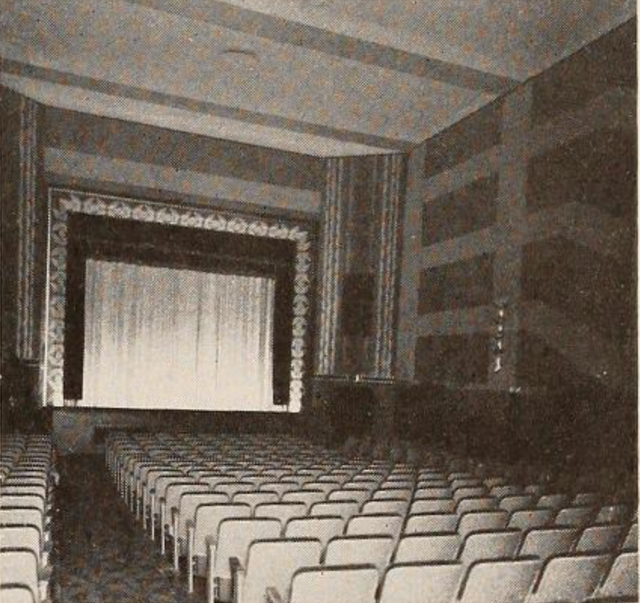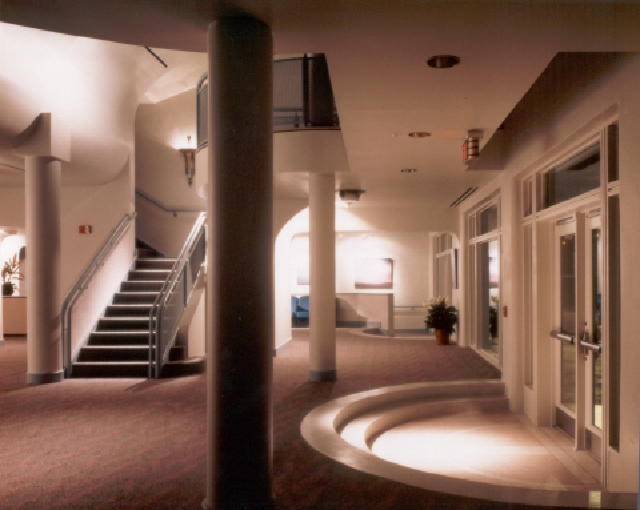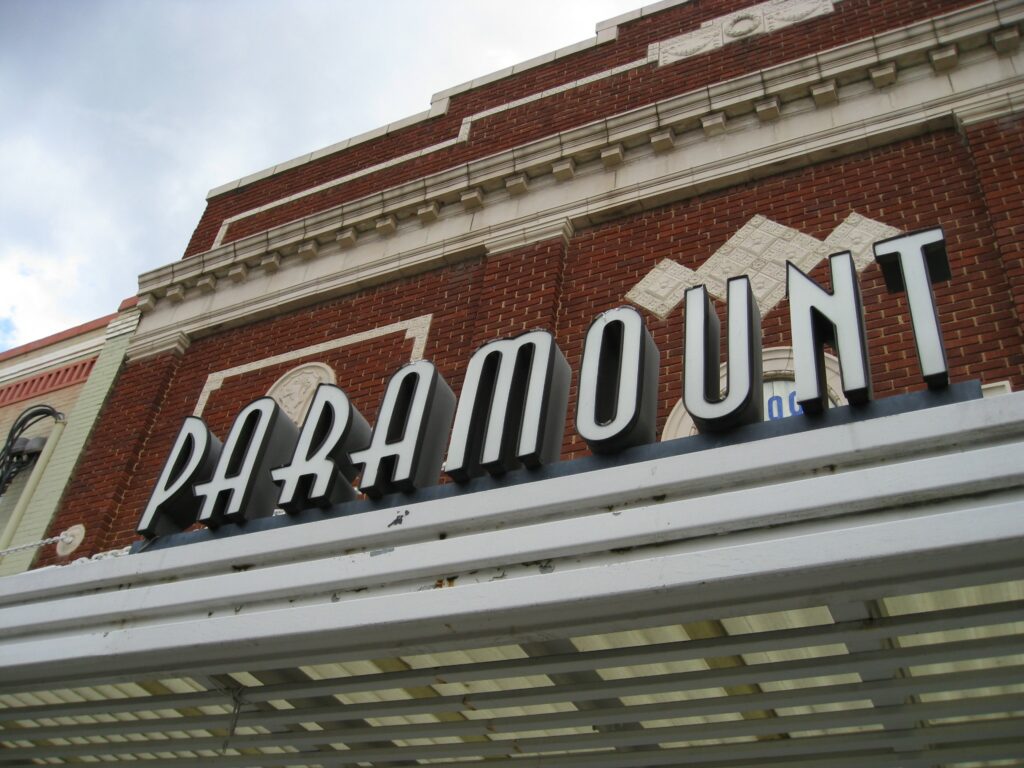
At some point in the early spring of 1929, J. R. Qualls and Direction Stevenson began negotiations that culminated in the latter’s decision to withdraw completely from the Burlington market. The decision was announced on the day the transfer took place, June 11, 1929. No reason was ever given for Direction-Stevenson’s decision to sell out, but it was likely financial. The company may not have been able to afford the investment in sound equipment needed so that the Carolina could compete with the Grand. In addition to the Carolina Theatre, J. R. Qualls also acquired Direction-Stevenson’s interest in the Lyric, which had apparently been closed for over a year. The June 11, 1929 notice in the Burlington Daily Times made the following comment regarding the Lyric: Nothing definite has been mapped out for the Lyric, across the street from the Carolina. There is a possibility that it may be used during the fall or winter for vaudeville, but no bookings have yet been made. However, the Lyric was never reopened. On August 17, 1929, J. R. Qualls announced that the Grand would be renamed “Paramount” at the beginning of September. He stated that Webster’s dictionary defined “paramount” as “supreme or superior to others,” and this was the reason he selected the name. The last movie at the Grand was Our Modern Maidens, starring Joan Crawford (who made a personal visit to Burlington on May 5-6, 1967), which played August 30 and 31. The sign was changed on Sunday, while the theater was closed, and the Grand formally became the Paramount Theatre on Monday, September 2. On November 30, 1929, J. R. Qualls announced further that the Carolina Theatre would be “remodeled and renovated throughout” and would also be receiving the same Western Electric sound equipment that was being used at the Paramount, “at once.” He said the public “preferred sound pictures” and that’s why he was installing “talking equipment” at the 25 Carolina.
Qualls added the equipment had been purchased and would be installed concurrently with a renovation project that was underway and expected to be completed by December 25. He also said the name of the theater would be changed to “Greater Carolina Theatre” (although this apparently did not occur). The Carolina was closed on Monday, December 23, and reopened at 1:00 p.m. on Tuesday, December 24 with Salute, starring George O’Brien. With the installation of the sound equipment at the Carolina, Burlington was the equal of any city in North Carolina, none of which had more than two theaters equipped with sound.
On April 23, 1930 a story appeared in the Greensboro Daily News containing a rumor that the Publix-Saenger theater chain “will shortly enter Burlington” and would build a “1,000-seat theater.” The rumor about Publix-Saenger entering Burlington was correct, but the company did not build a new theater. Instead, it was announced on Friday, June 28, 1929 that the company would be acquiring the Paramount, Carolina, and Lyric theaters on Monday, June 30. On June 14, 1930, just two weeks before ownership was to be transferred to Publix-Saenger, a fire broke out in the Paramount’s booth. Everette Qualls was the projectionist that evening and was showing The Divorcee, with Norma Shearer. He was rewinding one of the 2,000-foot reels when it suddenly burst into flame, as nitrate film often did. The room soon filled with smoke and he had to evacuate. Presumably he pulled the pin from the chain and released the steel shutters, sealing the room. The fire department arrived a few minutes later and extinguished the blaze. Only the one reel of film was destroyed. The Paramount reopened on schedule on Monday.
The Qualls family’s one year and nineteen-day monopoly on the movie theater business in Burlington ended when the transfer to Publix[1]Saenger took place as scheduled on Monday, June 30, 1930. Harold Thomas “Dick” Lashley was sent to Burlington from Raleigh to be overall city manager and manage the Paramount. Everette Qualls was retained as manager of the Carolina Theatre—at least for a while. Both the Paramount and Carolina theaters came perilously close to being destroyed by fire the day after they were acquired by Publix-Saenger. On the night of Tuesday, July 1, 1930, at about 7:15 that evening, just after the last employee left the F. J. Strader Produce Store (now Valerio’s Restaurant), which connected with the two theaters at the back and on one side, a fire broke out on the store’s second floor.
Patrons in both theaters had just been seated for the first evening performances when the ushers came through and asked them to leave. There was no panic because the ushers did 26 not shout “fire,” and many people were surprised to see the smoke once they got out on the street. The Burlington Fire Department, which was then located one block away in the Municipal Building at the northwest corner of Worth and West Front streets, was quickly on the scene, but the Graham Fire Department had to be called in to help fight the blaze. Neither the Paramount nor the Carolina suffered any damage, but the interior of the Strader building was “half gutted” by the fire. However, it was rebuilt beginning in late September, and reopened for business by mid-December.
The Carolina Theatre nearly burned down a second time early in the morning of Monday, October 2, 1933. At 12:01 that morning the Carolina presented a stage show called Scandals, which featured 20 beautiful girls. It was over before 2:00 a.m. and the theater was closed. At about 5:30 a.m., however, police officer Jesse Winningham, who was patrolling downtown on his motorcycle, noticed the glow of a fire atop the Carolina. There had been a severe thunderstorm that morning and evidently at some point after the theater had closed around 2:00 a.m. the building had been struck by lightning. Officer Winningham hopped off his motorcycle, ran to the nearest fire call box, pulled the lever, but nothing happened. He then raced around the corner and down the block to the fire department and pulled the fire alarm there. Again, nothing happened. So, he put on his siren and went to the homes of Chief Grover D. Moore and Assistant Chief Hobart Steele to alert them. In the meantime, Egbert Riddle climbed to the top of the bell tower and began ringing the fire bell by hand. Ironically, Burlington had been plagued with a series of false fire alarms in the past few weeks.
When the firemen finally arrived at the Carolina it became evident that the short ladders on the truck would not reach to the roof of the three[1]story building. In fact, it would not even reach the second-story windows. Several men were dispatched back to the station to get the department’s longest ladder and hand-carry it back to the theater, but at only 28 feet it was still woefully short of the roof. So, the firemen had to go inside and through the building to get up on the roof. 27 Fortunately, despite a lot of smoke, the fire was small and did not spread. Only a small hole was burned in the roof. This was quickly patched and the Carolina resumed normal operations very shortly.
The Paramount was remodeled during the spring of 1957, although it was nowhere near as extensive as its 1940 renovation. Because the Paramount was nearly 30 years old—ancient by movie theater standards —the remodeling was mostly cosmetic. The most noticeable change was the addition of a beige corrugated iron front, covering the entire front of the building from the marquee to the roof line, with the name “Paramount” in red plastic Arial-italic lettering on it. In the lobby the concession stand was moved back towards the east wall and remodeled. The foyer was also redecorated. The whole theater was repainted in a monochromatic beige, brown, and gold color scheme. New foam rubber padding was added to the seats, new lights were added, and the projectors received new lenses. Finally, a contour curtain was added in front of the screen. The Paramount reopened on April 8, 1957.

The Paramount Is Saved
After it opened the Terrace near Holly Hill Mall in March 1970, ABC Southeastern Theaters kept the Paramount in operation, but it was a consistent money-loser, usually averaging only a few hundred dollars in ticket sales per week. Therefore, it was closed on Thursday, August 12, 1971. The last film shown was the low-budget Private Duty Nurses. One week later, on August 19, it was announced that Burlington Amusement Company, which was owned by the Qualls family, had purchased the theater and it would reopen with Love Story on Friday, August 20. The Paramount received a new lease on life when it was announced one week later, on August 19, 1971, that Everette Qualls had purchased it, just over 41 years after his father had sold it. Its first feature under new management was Love Story, on August 20, 1971 (although the movie had previously played at the Cinema in Graham). After Everette died on October 24, 1973, at the age of 67, his son Ronald “Ronnie” Qualls continued to operate it for a few more years. However, the Qualls family lacked the resources to completely renovate the Paramount, which it desperately needed, and it continued to lose money. Therefore, the decision was made to close it for good on May 10, 1977. The last movie shown there was a low[1]budget horror film, The Child, which premiered on Friday, May 6, 1977 and closed (along with the theater) on Tuesday, May 10. After 70 years there were no more movie theaters in downtown Burlington. 48 The Paramount was scheduled for demolition by the Burlington Redevelopment Commission, which planned to use the site for a civic center. Luckily, by that time, people had begun to question the wisdom of the whole downtown redevelopment plan, which had proved to be an ill-conceived and expensive flop. Immediately after closing it as a movie theater, the Qualls family leased the Paramount to the Gallery Players, which had not had a permanent place in which to perform since it was formed in 1972. Although the lease was on a month-to-month basis, since the Paramount was still scheduled for demolition, the Gallery Players began the Herculean task of converting it into a stage theater. Throughout the summer of 1977 volunteers spent countless hours cleaning the Paramount, repairing seats, constructing a stage, and doing everything else necessary to turn the former movie theater into a performing arts theater. The results were far from ideal, since the Gallery Players did not have the financial resources necessary to carry out the full-scale renovations and repairs that were sorely needed, but it served the purpose for the next 23 years. By 1994, the Paramount was in such bad shape that the City of Burlington condemned the building and evicted the Gallery Players. But instead of demolishing the building, a three-year, $1.8 million renovation project took place. The corrugated iron front that was added in 1957 was removed, along with the marquee. The lobby was completely gutted and enlarged, and new restrooms were added. The only remnant of the original lobby is the 1940 box office, although it is now located inside the lobby area. Dressing rooms and a work space for erecting and storing sets were constructed behind the Moorefield Florist building and incorporated into the Paramount’s backstage area. The lobby renovation also incorporated the small, one-story building next door (at 134 East Front Street) as part of the Paramount. That building, which was also erected in 1928, initially housed a restaurant called “New Bright’s Café,” although little is known about it. A series of restaurants occupied the building before Howard’s Clothing took over the location prior to 1940, and that business remained there until the city took over the building.
The Future
The City of Burlington and the Alamance County Arts County took control of the deteriorating building in 1993, and a renovation was made for 1998 that included new seats and technical equipment. Many local community arts groups called it home, and some movies were also shown.
On November 5, 2024, the citizens of Burlington voted in favor of a bond referendum to refurbish the Historic Paramount theater and also construct a new Event Center next to it. These projects are hoped to serve as an anchor for downtown development.


